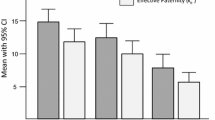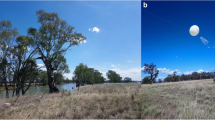Abstract
Honey bee males and queens mate in mid air and can fly many kilometres on their nuptial flights. The conservation of native honey bees, such as the European black bee (Apis mellifera mellifera), therefore, requires large isolated areas to prevent hybridisation with other subspecies, such as A. m. ligustica or A. m. carnica, which may have been introduced by beekeepers. This study used DNA microsatellite markers to determine the mating range of A. m. mellifera in two adjacent semi-isolated valleys (Edale and Hope Valley) in the Peak District National Park, England, in order to assess their suitability for native honey bee conservation and as isolated mating locations. Three apiaries were set up in each valley, each containing 12 colonies headed by a virgin queen and 2 queenright drone producing hives. The virgin queens were allowed to mate naturally with drones from the hives we had set up and with drones from hives owned by local beekeepers. After mating, samples of worker larvae were taken from the 41 queens that mated successfully and genotyped at 11 DNA microsatellite loci. Paternity analyses were then carried out to determine mating distances and isolation. An average of 10.2 fathers were detected among the 16 worker progeny. After correction for non-detection and non-sampling errors, the mean effective mating frequency of the test queens was estimated to be 17.2, which is a normal figure for honey bees. Ninety percent of the matings occurred within a distance of 7.5 km, and fifty percent within 2.5 km. The maximal mating distance recorded was 15 km. Queens and drones did occasionally mate across the borders between the two valleys, showing that the dividing mountain ridge Losehill does not provide complete isolation. Nevertheless, in the most isolated part of Edale sixty percent of all matings were to drones from Edale hives. The large majority of observed mating distances fell within the range of Hope Valley, making this site a suitable location for the long term conservation of a breeding population of black bees.
Similar content being viewed by others
References
Anonymus (1993) Danish law of beekeeping No 11, article 14
Baudry E, Solignac M, Garnery L, Gries M, Cornuet J-M, Koeniger N (1998) Relatedness among honeybees (Apis mellifera) of a drone congregation. Proc. R. Soc. Lond. B. 265: 2009–2014
Boomsma JJ, Ratnieks FLW (1996) Paternity in eusocial Hymenoptera. Phil. Trans. R. Soc. Lond. B. 351: 947–975
Böttcher FK (1975) Beiträge zur Kenntnis des Paarungsfluges der Honigbiene. Apidologie 6: 233–281
Châline N, Ratnieks FLW, Raine NE, Badcock NS, Burke T (2004) Non-lethal sampling of honey bee, Apis mellifera, DNA using wing tips. Apidologie 35: 311–318
Cooper BA (1986) The honeybees of the British Isles. British Isles Bee Breeder’s Association, Derby UK
Crozier RH (1979) Genetics of sociality. In: Hermann HR (eds). Social insects Vol.I. Academic Press, New York
Crozier RH, Page RE (1985) On being the right size: male contributions and multiple mating in the social hymenoptera. Behav. Ecol. Sociobiol. 18: 105–115
Dews JE, Milner E (1991). Breeding better bees using simple modern methods. British Isle Bee Breeder’s Association, Derby UK
Estoup A, Solignac M, Cornuet J (1994) Precise assessment of the number of patrilines and of genetic relatedness in honeybee colonies. Proc. R. Soc. Lond. B. 258: 1–7
Estoup A, Garnery L, Solignac M, Cornuet J (1995) Microsatellite variation in honey bee (Apis mellifera L.) populations: Hierarchical genetic structure and tests of infinite allele and stepwise mutation models. Genetics 140: 679–695
Forup LM, Memmott J (2005) The relationship between the abundances of bumblebees and honeybees in a native habitat. Ecol. Entomol. 30: 47–57
Franck P, Garnery L, Solignac M, Cornuet J-M (1998) The origin of West European subspecies of honeybees (Apis mellifera) new insights from microsatellite and mitochondrial data. Evolution 52: 1119–1134
Franck P, Koeniger N, Lahner G, Crewe RM, Solignac M (2000) Evolution of extreme polyandry: an estimate of mating frequency in two African honeybee subspecies, Apis mellifea monticola and A. m. scutellata. Insect. Soc. 47: 364–370
Garnery L, Franck P, Baudry E, Vautrin D, Cornuet J-M, Solignac M (1998 a) Genetic diversity of the west European honey bee (Apis mellifera mellifera and A. m. iberica). I. Mitochondrial DNA. Gen. Selec. Evol. 30: 31–47
Garnery L, Franck P, Baudry E, Vautrin D, Cornuet J-M, Solignac M (1998b) Genetic diversity of the west European honey bee (Apis mellifera mellifera and A. m. iberica). II. Microsatellites. Gen. Selec. Evol. 30: 49–74
Jensen AB, Palmer KA, Boomsma JJ, Pedersen, BV (2005) Varying degrees of Apis mellifera ligustica introgression in protected populations of the black honeybee,Apis mellifera mellifera, in northwest Europe. Mol. Ecol. 14: 93–106
Kauhausen-Keller D, Keller R (1994). Morphometrical control of pure race breeding of honeybee (Apis mellifera L). Apidologie 25: 133–143
Klatt G (1929) Züchtungsmöglichkeiten an der Wasserkante. Arch. F. Bienenkunden 10: 318–321
Klatt G (1932) Weiteren Befruchtungsmöglichkeiten an der Wasserkante. Arhc. F. Bienenkunden 13: 243–247
Kryher H, Laidlaw H, Page RE (1997) Queen Rearing and Bee Breeding. Wicwas Press, Chesire CT
Marshall TC, Slate J, Kruuk LEB, Pemberton JM (1998) Statistical confidence for likelihood-based paternity inference in natural populations. Mol. Ecol. 7: 639–655
Maul V, Hähnle A (1994) Morphometric studies with purebred stock of Apis mellifera carnica Pollmann from Hessen. Apidologie 25: 19–132
Moilanen A, Sundström L, Pedersen JS (2004) MATESOFT: a program for deducing parental genotypes and estimating mating system statistics in haplodiploid species Mol. Ecol. Notes 4: 795–797
Neumann P, Moritz RFA, van Praagh J (1999) Queen mating frequency in different types of honey bee mating apiaries. J. Api. Res. 38: 11–18
Olden JD, Poff NL, Douglas MR, Douglas ME, Fausch KD (2004) Ecological and evolutionary consequences of biotic homogenisation. Trends Ecol. Evol., 19, 18–24
Palmer KA, Oldroyd BP (2000) Evolution of multiple mating in the genus Apis. Apidologie 31: 235–248
Pamilo P (1993) Polyandry and allele frequency differences between the sexes in the ant Formica aquilonia. Heredity 70: 472–480
Peer DF, Farrar CL (1956) The mating range of the honey bee. J. Econ. Entomol. 49: 254–256
Peer DF (1957) Further studies on the mating range of the honey bee. Can. Entomol. 89: 108–110
Rhymer JM, Simberloff D (1996) Extinction by hybridisation and introgression. Ann. Rew. Ecol. Sys. 27: 83–109
Ruttner H (1976) Untersuchungen über dei flugaktivität und das paarungsverhalten der drohnen. VI. Flug auf und über höhenrücken. Apidologie 7: 331–341
Ruttner F (1988a) Biogeography and taxonomy of honey bees. Springer Verlag, Berlin
Ruttner F (1988b) Breeding techniques and selection for breeding of honey bee. Ehrenwirth Verlag, Munich
Ruttner F, Ruttner H (1966) Untersuchungen über die Flugaktivität und das Paarungsverhalten der Drohnen. 2. Flugweite und Flugrichtung der Drohnen. Z. Bienenforsch. 8: 332–354
Solignac M, Vautrin D, Loiseau A, Mougel F, Baudry E, Estoup A, Garnery L, Haberl M, Cornuet JM (2003) Five hundred and fifty microsatellite markers for the study of the honeybee (Apis mellifera L.) genome. Mol. Ecol. Notes 3: 307–311
Tarpy DR, Nielsen DI (2002) Sampling error, effective paternity, and estimating the genetic structure of honey bee colonies (Hymenoptera: Apidae). Ann. Entomol. Soc. Am. 95: 513–528
Walsh PS, Metzger DA, Higuchi R (1991) Chelex-100 as a medium for simple extraction of DNA for PCR-based typing from forensic material. Biotechniques 10: 506–513
Winston ML (1987) The Biology of Honey bee. Harvard University Press, Cambridge Massachusetts
Woyke J (1964) Cause of repeated mating flights by queen honeybees. J. Api. Res. 3: 17–23
Acknowledgements
ABJ, KAP, and NC were funded by the EU (FW5-ENV) research network ‘Beekeeping and Apis Biodiversity in Europe’ (BABE) (contract EVK2-CT-2000-00068). We thank the local (East Midlands) branch of BIBBA (Bee Improvement and Bee Breeders Association) and beekeepers and landowners in Edale and Hope Valley for their assistance during the bee sampling and for providing land to set up apiaries.
Author information
Authors and Affiliations
Corresponding author
Rights and permissions
About this article
Cite this article
Jensen, A.B., Palmer, K.A., Chaline, N. et al. Quantifying honey bee mating range and isolation in semi-isolated valleys by DNA microsatellite paternity analysis. Conserv Genet 6, 527–537 (2005). https://doi.org/10.1007/s10592-005-9007-7
Received:
Accepted:
Published:
Issue Date:
DOI: https://doi.org/10.1007/s10592-005-9007-7




